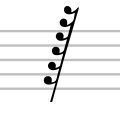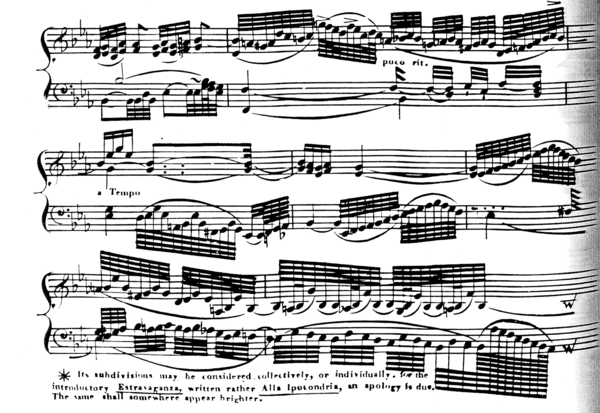Two hundred fifty-sixth note

In music, a two hundred fifty-sixth note (or occasionally demisemihemidemisemiquaver)[1] is a note played for 1⁄256 of the duration of a whole note. It lasts half as long as a hundred twenty-eighth note and takes up one quarter of the length of a sixty-fourth note. In musical notation it has a total of six flags or beams. Since human pitch perception begins at 20 Hz (1200/minute), then a 256th-note tremolo becomes a single pitch in perception at quarter note ≈ 80 bpm.
A single 256th note is always stemmed with flags, while two or more are usually beamed in groups.[2] Notes this short are very rare in printed music but not unknown. One reason that notes with many beams are rare is that, for instance, a thirty-second note at ![]()
![]()
 256th note
256th note 256th rest
256th rest
Even shorter notes

The next note value shorter than the two hundred fifty-sixth note is the five hundred twelfth note with seven flags or beams; it is half as long as the two hundred fifty-sixth note. After this would come the one thousand twenty-fourth note (eight flags or beams), the two thousand forty-eighth note (nine flags or beams), the four thousand ninety-sixth note (ten flags or beams), and so on indefinitely, with each note half the length of its predecessor. The shortest note value to have ever been used in a published work is the 1024th note (notated incorrectly as a 2048th) in Anthony Philip Heinrich's Toccata Grande Cromatica from The Sylviad, Set 2, written around 1825; 256th notes occur frequently in this piece, and some 512th notes also appear; the passage is marked grave but the composer also intended a huge ritardando.[3] For comparison, the shortest notated duration supported by Finale is a 4096th note,[9] while LilyPond can write notes with up to 27 beams, as short as a 1073741824th (= 2−30) note.[10] 512th notes are easily accessible in Sibelius as of version 5.
Brian Ferneyhough uses many note and rest values well smaller than 256th in his 2014 work Inconjunctions. In addition to occasional 512th and 1024th rests, there are multiple examples of 4096th notes. Many of these are also contained within tuplets, making their ratio to the whole note even smaller.[11]
See also
References
- ↑ K. Asooja, S. K. Ernala, and P. Buitelaar [2014]. "UNLP at the C@merata Task: Question Answering on Musical Scores ACM", CSEE.Essex.ac.UK. Paper describing submission to the C@merata task in MediaEval 2014.
- ↑ Gerou, Tom (1996). Essential Dictionary of Music Notation, p.211. Alfred. ISBN 0-88284-730-9
- 1 2 3 4 Byrd, Donald (ongoing, revised February 2017). "Extremes of Conventional Music Notation", Informatics.Indiana.edu.
- ↑ Mozart, Wolfgang Amadeus. Zwölf Variationen in Es über die Romanze "Je suis Lindor"', K.354. p. 46, fifth system, first bar. Neue Mozart-Ausgabe. (imslp.org)
- ↑ Thomas Bushnell BSG (8 November 2007). "Re: GPD: official shortest note in lilypond". mail-archive.com.
- ↑ Piano Sonata No.5, Op.10 No.2 (Dussek, Jan Ladislav): Scores at the International Music Score Library Project (IMSLP). Score of Dussek's Piano Sonata, Op. 10 No. 2 at IMSLP; the 256th notes appear on p.14 (p.3 of the pdf)
- ↑ Recorder Concerto in C major, RV 444 (Vivaldi, Antonio): Scores at the International Music Score Library Project (IMSLP)
- ↑ François Couperin, L'Art de toucher le Clavecin: Intermediate to Early Advanced Piano Collection (facsimiles from the editions of 1716 and 1717), second edition, edited and translated by Margery Halford, p.6. [S.l.]: Alfred Music, 2008. ISBN 9781457442148.
- ↑ "Secondary Beam Break Selection". finalemusic.com. Archived from the original on 2016-03-04.
- ↑ Albrecht, Simon (10 Sep 2015). "Minimum possible duration". gnu.org. Response to Wikipedia.
- ↑ "Ferneyhough - Inconjunctions Full Score EP72630", Issuu.com/EditionPeters.